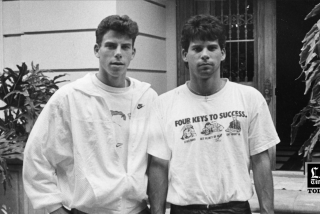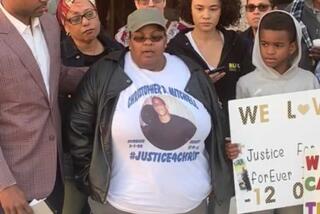New Potential for Rampart Mistrial Surfaces
The judge in the Rampart trial indicated Wednesday that three Los Angeles police officers convicted of framing gang members may have grounds for a new trial because a computer mistake on a key piece of evidence could have misled jurors.
âI am troubled. . . . This is not a small issue,â Los Angeles Superior Court Judge Jacqueline A. Connor said, describing a police report that mistakenly exaggerated the injuries the police officers said they suffered.
The Nov. 15 convictions, which came after a monthlong trial, were the first in an ongoing investigation into allegations of police corruption in the Rampart Division of the Los Angeles Police Department.
Prosecutors and defense attorneys had gathered Wednesday in Connorâs courtroom to delve into an allegation of jury misconduct. An alternate juror, Wendy Christiansen, said that Victor Flores, who was later elected jury foreman, told her he had made up his mind to convict the officers before hearing any testimony.
But after the misconduct allegation dissolved into a he-said-she-said debate, the hearing quickly turned into a discussion over the language of a police report. Officers alleged in the report that gang members hit them with a pickup truck in an alley during a July 1996 gang sweep.
Jurors relied on the report to convict Sgts. Edward Ortiz, 44, Brian Liddy, 39, and Officer Michael Buchanan, 30, of conspiracy and perjury for fabricating charges against the gang members. The jury acquitted a fourth police officer.
But defense attorneys said three jurors have told their investigators that they couldnât agree on whether the officers were actually hit by gang members.
Instead, some of them took literally a line in the report, which said the officers were victims of assault with a deadly weapon with great bodily harm. The officers did not suffer great bodily injury, the jurors concluded, therefore they lied and were guilty of framing the gang members.
The problem is the report should have said the officers were victims of assault with a deadly weapon by means likely to produce great bodily injury.
The officers never claimed they suffered great bodily injury, only that their attackers intended to seriously hurt them. But on the police report reviewed by jurors, a computer software program incorrectly printed, âADW w/GBI,â giving the impression the officers were claiming serious injury. No one caught the mistake during the trial.
In the end, the seemingly minor distinction could result in a new trial, although legal experts say proving the defendants should get a new trial based on juror confusion is difficult. A hearing is set for Dec. 15.
Connor has asked defense attorneys to get an affidavit from at least one juror confirming that the computer mistake led them off track during deliberations.
âThey were deciding a false issue,â defense attorney Harland Braun said. âThese officers were convicted on what a computer spit out.â
But Deputy Dist. Atty. Laura Laesecke tried to persuade Connor not to hold the hearing, saying it was premature because defense attorneys had come to court armed only with hearsay, not facts.
âWe should not be putting the jury on trial,â Laesecke said, adding that the deliberative process was entitled to a veil of secrecy.
Flores said in an interview Wednesday that the jury discussed the issue of whether the officers suffered great bodily harm for about two hours on the final day of deliberations.
But Flores said he believed all the jurors agreed the officers made up the entire story about being hit by a car.
âI donât feel the verdict was based just on the fact of whether they suffered great bodily injury,â Flores said. âAt least for me it wasnât.â
Outgoing Dist. Atty. Gil Garcetti heralded the verdicts last week as a sign that corruption in the LAPD would not be tolerated.
But shortly after the convictions were announced, questions began to surface about the conduct of the jurors.
Until Wednesday, the controversy had centered on whether Flores prejudged the defendants and whether jurors made snide comments about defense attorneys during court breaks.
At a hearing last week, Christiansen testified that Flores told her and another alternate at lunch on the first day of the trial that the defendants were guilty. She said she left the lunch early because she was uncomfortable with the conversation.
Foreman Denies the Allegations
Flores was called to court Wednesday to answer to those allegations. He testified that he had lunch with Christiansen and another alternate at the mall under the Childrenâs Museum.
But he said they talked about their sandwiches and jobs, not the guilt or innocence of the defendants.
âNo. Not by me,â he replied when Connor asked whether the subject of guilt or innocence was discussed. He did, however, confirm that Christiansen left the table early, but he said he was not sure why.
Connor said she did not have enough evidence to determine who was telling the truth. She has been unable to reach the other alternate juror who was at lunch with Flores and Christiansen. The alternate, an accountant, is believed to be in Colombia for the holidays visiting her mother. Connor said she will continue to try to reach her so the matter can be resolved.
Defense attorneys Barry Levin and Braun said they will pursue both tracks in their quest for a new trial: jury misconduct and the erroneous police report.
Buoyed by Connorâsâ comments from the bench Wednesday, they seemed confident that the mistake on the police report could be their key to retrials.
Levin and Braun said they began to suspect the jurors were confused during deliberations when the jury asked to rehear testimony from Ortiz, in which he described his injuries.
Their fears were confirmed, Braun said, when the jurors met with the attorneys and prosecutors after the convictions and indicated that the question of whether the officers suffered great bodily harm was an important issue in deliberations.
Braun said the defense team did not immediately pursue the issue because it was sidetracked by misconduct allegations.
âThese convictions will be thrown out,â Levin said at a news conference after the hearing.
Legal experts were not as certain.
First, the defense must show that the police report qualifies as âplain error,â said Loyola law professor Laurie Levenson. According to U.S. Supreme Court decisions, said UCLA law lecturer George Cardona, plain error is one that should have been obvious to the judge when it occurred, even if a party did not object at the time, and could have produced a miscarriage of justice.
âThe defense had an opportunity to object during the trial. The bar is higher now. We set the bar higher after trial because otherwise every losing party could come in and second-guess not only every jury verdict but how the judge presented the case to the jury,â Levenson said.
While probing the deliberations of the jurors, the judge is bound by a section of the California evidence code that deals with jury misconduct. Connor will be able to question what was said during deliberation but not what jurors were thinking.
âWhat the law basically says is we can look to see if there was juror misconduct but we canât use evidence to invade the jurorsâ mental processes,â Levenson said.
If Connor declares a mistrial, prosecutors will have a hard time getting the ruling reversed.
âThe prosecution can appeal a judgeâs decision granting a new trial, but because it is a discretionary decision by the judge, ordinarily it will not be set aside unless there is a manifest and unmistakable abuse of discretion,â she said.
More to Read
Sign up for Essential California
The most important California stories and recommendations in your inbox every morning.
You may occasionally receive promotional content from the Los Angeles Times.










